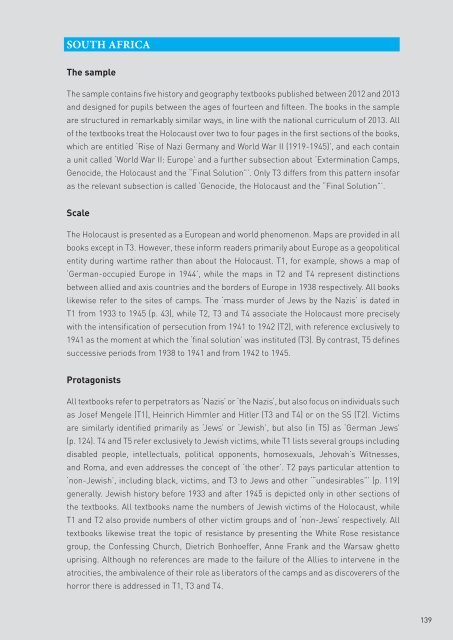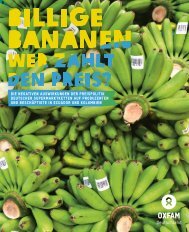228776e
228776e
228776e
Create successful ePaper yourself
Turn your PDF publications into a flip-book with our unique Google optimized e-Paper software.
SOUTH AFRICA<br />
The sample<br />
The sample contains five history and geography textbooks published between 2012 and 2013<br />
and designed for pupils between the ages of fourteen and fifteen. The books in the sample<br />
are structured in remarkably similar ways, in line with the national curriculum of 2013. All<br />
of the textbooks treat the Holocaust over two to four pages in the first sections of the books,<br />
which are entitled ‘Rise of Nazi Germany and World War II (1919-1945)’, and each contain<br />
a unit called ‘World War II: Europe’ and a further subsection about ‘Extermination Camps,<br />
Genocide, the Holocaust and the “Final Solution”’. Only T3 differs from this pattern insofar<br />
as the relevant subsection is called ‘Genocide, the Holocaust and the “Final Solution”’.<br />
Scale<br />
The Holocaust is presented as a European and world phenomenon. Maps are provided in all<br />
books except in T3. However, these inform readers primarily about Europe as a geopolitical<br />
entity during wartime rather than about the Holocaust. T1, for example, shows a map of<br />
‘German-occupied Europe in 1944’, while the maps in T2 and T4 represent distinctions<br />
between allied and axis countries and the borders of Europe in 1938 respectively. All books<br />
likewise refer to the sites of camps. The ‘mass murder of Jews by the Nazis’ is dated in<br />
T1 from 1933 to 1945 (p. 43), while T2, T3 and T4 associate the Holocaust more precisely<br />
with the intensification of persecution from 1941 to 1942 (T2), with reference exclusively to<br />
1941 as the moment at which the ‘final solution’ was instituted (T3). By contrast, T5 defines<br />
successive periods from 1938 to 1941 and from 1942 to 1945.<br />
Protagonists<br />
All textbooks refer to perpetrators as ‘Nazis’ or ‘the Nazis’, but also focus on individuals such<br />
as Josef Mengele (T1), Heinrich Himmler and Hitler (T3 and T4) or on the SS (T2). Victims<br />
are similarly identified primarily as ‘Jews’ or ‘Jewish’, but also (in T5) as ‘German Jews’<br />
(p. 124). T4 and T5 refer exclusively to Jewish victims, while T1 lists several groups including<br />
disabled people, intellectuals, political opponents, homosexuals, Jehovah’s Witnesses,<br />
and Roma, and even addresses the concept of ‘the other’. T2 pays particular attention to<br />
‘non-Jewish’, including black, victims, and T3 to Jews and other ‘“undesirables”’ (p. 119)<br />
generally. Jewish history before 1933 and after 1945 is depicted only in other sections of<br />
the textbooks. All textbooks name the numbers of Jewish victims of the Holocaust, while<br />
T1 and T2 also provide numbers of other victim groups and of ‘non-Jews’ respectively. All<br />
textbooks likewise treat the topic of resistance by presenting the White Rose resistance<br />
group, the Confessing Church, Dietrich Bonhoeffer, Anne Frank and the Warsaw ghetto<br />
uprising. Although no references are made to the failure of the Allies to intervene in the<br />
atrocities, the ambivalence of their role as liberators of the camps and as discoverers of the<br />
horror there is addressed in T1, T3 and T4.<br />
139




